- Joined
- Feb 2, 2011
- Messages
- 2,093
NEW RELEASES FOR AUGUST 2024
THE EIGHTEENTH CENTURY COLLECTION
THE AMERICAN WAR OF INDEPENDENCE
THE BATTLE OF BUNKER HILL, 17th JUNE 1775.
THE ASSAULT ON THE REDOUBT AT BREED’S HILL
Boston was the third largest town in North America, and stood on a Peninsula connected to the mainland by a neck just wide enough to cross at high tide. The harbour, large enough to be strategically significant, and central to the town’s economy, was formed by a chain of islands stretching out to sea, guarded by reefs and ledges.
North west of Boston was Charlestown, a largely rural peninsula one and a half miles long. Charlestown stood at the south east corner with three hills behind it. Bunker’s Hill, nearest the neck of the Peninsula, Breed’s Hill 200 yards above the town and Moulton’s Hill to the north east.

On the 16th June 1775, 3 detachments from Massachusetts regiments under the command of Colonel William Prescott and engineer Captain Richard Gridley, crossed the Charlestown neck and arrived at Bunker Hill.
Captain Richard Gridley and Prescott disagreed as to where they should locate their defense. Some work was performed on Bunker Hill, but Breed’s Hill was closer to Boston and viewed as being more defensible, and they decided to build their primary redoubt there.
Prescott and his men began digging a square fortification about 130 ft a side with ditches and earthen walls. The walls of the redoubt were about 6 feet high.
Work began at midnight, and around 4am one of the British warships spotted the earthworks on Breed’s Hill and opened fire.
The British command agreed that the works posed a significant threat, but were at this time sufficiently incomplete and isolated to offer a chance of a successful attack.
The original British plan was to bypass the redoubt to the north and capture Bunker’s Hill and the neck of the peninsula, thus isolating the redoubt on Breed’s Hill.
The Americans repulsed two British assaults, with significant British casualties. The British captured the redoubt on their third assault, after the defenders had run out of ammunition. The colonists retreated over Bunker Hill, leaving the British finally in control of the Peninsula.
The battle was a tactical victory for the British, but it proved to be a sobering experience for them; they incurred many more casualties than the Americans had sustained, including many officers. The battle had demonstrated that inexperienced militia were able to stand up to regular army troops in battle. Subsequently, the battle discouraged the British from any further frontal attacks against well defended front lines. American casualties were much fewer, although their losses included General Joseph Warren, and Major Andrew McClary, the final casualty of the battle.
BRITISH MARINES
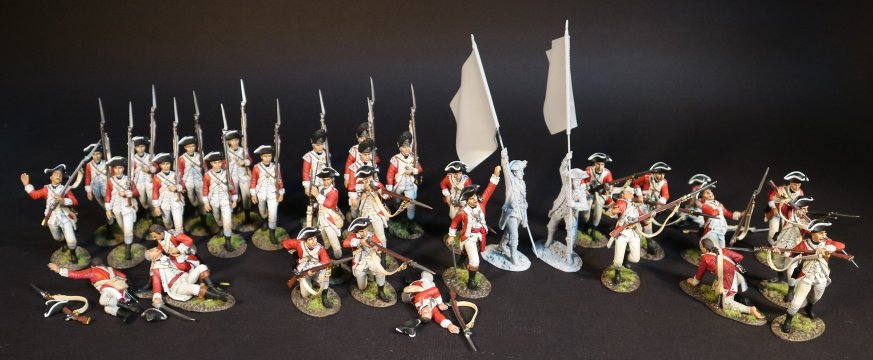
The Marines, which only became “Royal Marines” in 1802, were the Royal Navy’s private army, administered by the Admiralty and controlled by senior naval officers. The rank and file were volunteers and wore army style uniforms and equipment. However they were trained to serve on warships and undertake amphibious operations. The 50 companies, shared between Chatham, Portsmouth and Plymouth, were not regimented, and detachments, or in some cases individual replacements were assigned on an ad hoc basis.
The first Marines sent to Boston were to form a battalion of 600 men under Major Pitcairn, but by March only 336 were present, as they soon became an object of inter service rivalry over pay, food and conditions. Although initially physically inferior to their army comrades, and short of essential equipment for service on land, incessant drilling and regular marches into the countryside soon created a fine unit.
Another group of over 700 men arrived in May, and the whole force formed two battalions, with grenadier and light companies.
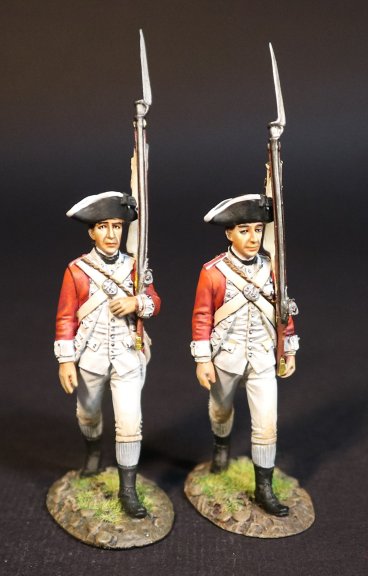
MBHL-05
THE AMERICAN WAR OF INDEPENDENCE 1775-1783,
THE BATTLE OF BUNKER HILL, JUNE 17th 1775,
THE ASSAULT ON THE REDOUBT AT BREED’S HILL,
BRITISH MARINES,
2 MARINES MARCHING
The 1st and 2nd Marines were to play an important part in the assault on the southern defences of the Breed’s Hill redoubt.
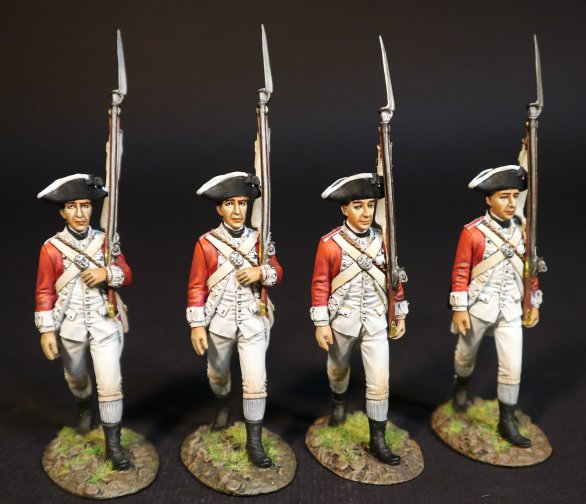
MBHL-05N
THE AMERICAN WAR OF INDEPENDENCE 1775-1783,
THE BATTLE OF BUNKER HILL, JUNE 17th 1775,
THE ASSAULT ON THE REDOUBT AT BREED’S HILL,
BRITISH MARINES,
4 MARINES MARCHING
It was during one of the assaults by the 47th Regiment and the 1st Marines, that the American commander Prescott ordered his men to hold their fire until the British were within 30 yards. This action supposedly gave rise to the order, “Don’t fire till you see the whites of their eyes”!
The volley forced the Marines and regulars back out of range to regroup.
Adjutant, Lieutenant Waller, managed to reform two companies, and with the 47th Regiment on their left, the two battalions finally swarmed over the defences and into the redoubt, probably being the first troops to enter.
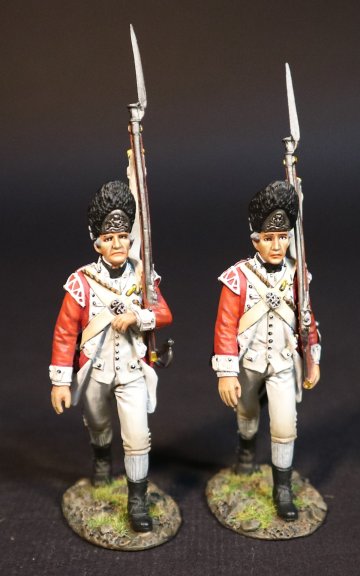
MBHL-06
THE AMERICAN WAR OF INDEPENDENCE 1775-1783,
THE BATTLE OF BUNKER HILL, JUNE 17th 1775,
THE ASSAULT ON THE REDOUBT AT BREED’S HILL,
BRITISH MARINES,
2 MARINE GRENADIERS MARCHING
This third attack was made at the point of the bayonet and successfully carried the redoubt. However the final volleys of fire from the colonists cost the life of Major Pitcairn. The defenders had run out of ammunition, redusing the battle to close combat. The advantage turned to the British as their troops were equipped with bayonets on their muskets, while most of the colonists were not.
Colonel Prescott, one of the last men to leave the redoubt, parried bayonet thrusts with his normally ceremonial saber.
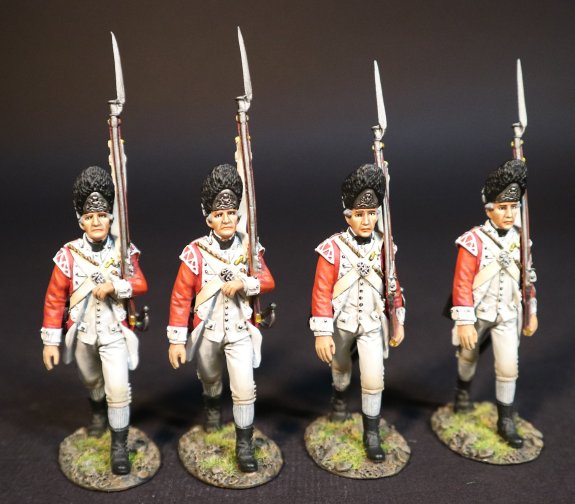
MBHL-06N
THE AMERICAN WAR OF INDEPENDENCE 1775-1783,
THE BATTLE OF BUNKER HILL, JUNE 17th 1775,
THE ASSAULT ON THE REDOUBT AT BREED’S HILL,
BRITISH MARINES,
4 MARINE GRENADIERS MARCHING
THE BATTLE OF COWPENS, JANUARY 17th, 1781.
THE 7th REGIMENT OF FOOT (ROYAL FUSILIERS.)
The Battle of Cowpens was an engagement during the American Revolutionary War fought on January 17th 1781, near the town of Cowpens, South Carolina, between American forces under Brigadier General Daniel Morgan, and British forces under Lieutenant Colonel Banastre Tarleton, as part of the campaign in the Carolinas.
The battle was a turning point in the American reconquest of South Carolina from the British.
Tarleton’s force of 1,000 British troops were set against 2,000 troops under Morgan. Morgan’s forces suffered casualties of only 25 killed and 124 wounded. Tarleton’s force was almost completely eliminated with almost 30% casualties and 55% of his force captured or missing, with Tarleton himself and only about 200 British troops escaping.
Morgan’s forces conducted a double envelopment of the British forces, the only double envelopment of the war.
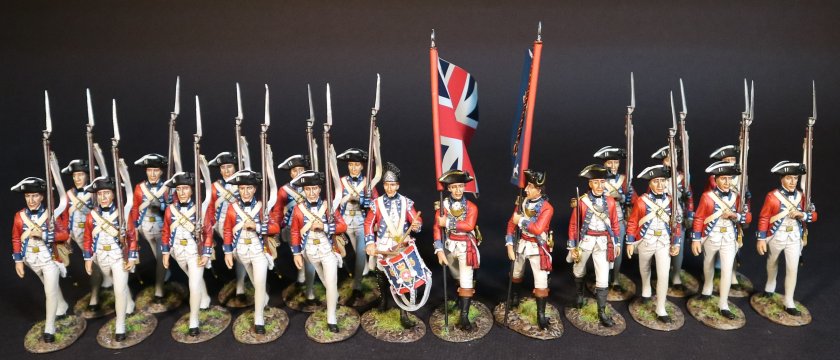
The Royal Fusiliers (city of London Regiment) was a line infantry regiment of the British Army which has been in continuous existence for 283 years. It was known as the 7th Regiment of Foot until the Childers Reforms in 1881.
In 1747 the regiment was known as the Royal English Fuziliers and was given the precedence of 7th in the Infantry of the Line. On 1st July 1751 it was redesignated as the 7th Regiment of Foot (Royal Fusiliers).
When county titles were added in August 1782 the subtitle (Derbyshire) was added, but this was never used and was later given to a different regiment.
The Royal Fusiliers were sent to Canada in April 1773. The regiment was broken up into detachments that served at Montreal, Quebec, Fort Chambly and Fort St. Johns. In the face of the American invasion of Canada in 1775/76, the 80 man garrison of Fort Chambly attempted to resist a 400 man Rebel force but ultimately had to surrender, losing its regimental colours as a result. The bulk of the regiment was captured when St. John’s fell.
A 70 man detachment under the command of Captain Humphrey Owens assisted with the Battle of Quebec in December 1775.
The men taken prisoner during the defence of Canada were exchanged in British held New York city in December 1776. Here the regiment was rebuilt and garrisoned New York and New Jersey. In October 1777, the 7th participated in the successful assaults on Fort Clinton and Fort Montgomery and the destruction of enemy stores at Continental Village. In late November, 1777 the regiment reinforced the garrison of Philadelphia. During the British evacuation back to New York city, the regiment participated in a diversionary raid in the days leading up to the Battle of Monmouth in June 1778.
In April 1780, the Royal Fusiliers took part in the capture of Charleston. Once Charleston fell, the regiment helped garrison the city. Three companies were sent to Ninety-Six to assist with the training of Loyalist militia companies. An 80 man detachment was also sent to Camden, South Carolina to help build that town’s defences. The detachments were recalled to Charleston for refitting in late August 1780.
The 7th, mounted on horses, along with the two regiments of Loyalist militia, cleared the region north of Georgetown, South Carolina of partisans while en route. The Royal Fusiliers turned the horses over to Lieutenant Colonel Banastre Tarleton’s British Legion upon uniting with Cornwallis in late September and then served as the Army’s rearguard.
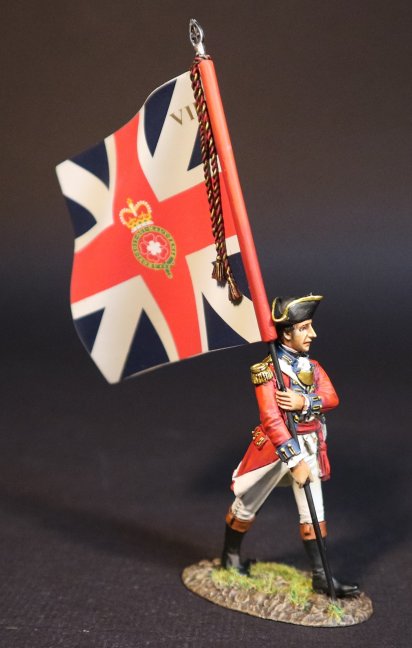
CW7FL-03
THE AMERICAN WAR OF INDEPENDENCE 1775-1783,
THE BATTLE OF COWPENS, JANUARY 17th 1781,
7th REGIMENT OF FOOT (ROYAL FUSILIERS.)
STANDARD BEARER
Between October 1780 and early 1781, the regiment, having lost about one third of its officers and men to sickness and disease, protected the communication and supply lines between Camden and Winnsboro, South Carolina. On 7th January, 1781, a contingent of 171 men from the Royal Fusiliers was detached from Cornwallis’s Army and fought under the command of Tarleton at the Battle of Cowpens in January 1781.
The Royal Fusiliers were on the left of the line of battle: Tarleton was defeated and the regiment’s colours were once again captured, and stored in the baggage wagons.
A 19 man detachment from the regiment fought through North Carolina participating in the Battle of Guilford Court House in March 1781 and ultimately the siege of Yorktown, where it served with the regiment’s Light Infantry Company. There was another detachment, composed largely of men recovered from the hospitals and recruits, which remained in the South under the command of Lt. Col. Alured Clarke. These men remained in garrison in Charleston, until they were transferred to Savannah, Georgia in December 1781.
The regiment returned to England in 1783.
THE SEVEN YEARS WAR
THE THIRD CARNATIC WAR 1756-1763
THE BATTLE OF WANDEWASH, 22nd JANUARY 1760
THE BRITISH ARMY
The Battle of Wandewash was a confrontation between the French under the command of The Comte de Lally, and the British Sir Eyre Coote. It was the decisive battle in the Anglo French struggle in southern India during the Seven Years War.
Lally, cut off from sea support by the withdrawal of Admiral d’Aché’s fleet and hampered by a lack of funds and by dissensions among his troops, tried to recover the fort of Wandiwash near Pondicherry.
There he was attacked and routed by Coote, with about 1,700 British troops against about 2,000 French. Lally’s best general, the marquis de Bussy, was captured. The French were thereafter confined to Pondicherry, which surrendered on Jan. 16, 1761, after much privation. Lally was later imprisoned and executed, after a trial in Paris, for alleged treason
The following two British regular units served in India and were present at the battle of Wandewash. It should be noted however that it was rare for these units to serve as complete battalions, and that they were generally broken up into detachments.
The British 79th Regiment of Foot, was raised in November 1757, originally as the 64th with drafts taken from the 4th, 8th and 24th foot, but was later re-numbered during the shake up after various second Battalions were taken into the line.
The regiment was to mainly see service in India from 1758, and was disbanded in 1764. Its commander was Major Brereton.
The 84th (Coote’s) Regiment was raised in January 1759, specifically for service in India.
The regiment was ordered home to be disbanded in 1764, but was instead reduced in India and most of the personnel were to enter the East India Company service.
Initially the Madras European Regiment were not conventionally organized infantry battalions. Their organization, or what there was of it, resembled that of the marines, serving in effect as a pool from which more or less ad hoc companies and detachments could be formed for specific tasks.As long as the East India Company’s need was for purely defensive forces, tasked with watching over its factories and escorting merchants and officials this informal organization was adequate.
BRITISH SEPOYS

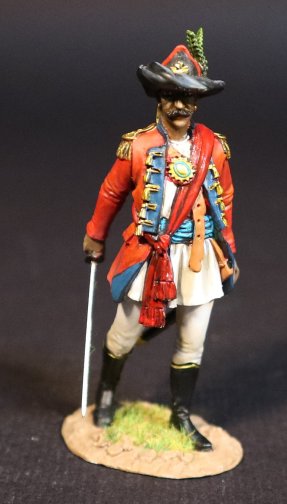
WBS-01
THE SEVEN YEARS WAR,
THE THIRD CARNATIC WAR 1756-1763,
THE BATTLE OF WANDEWASH, 22nd JANUARY 1760,
THE BRITISH ARMY,
BRITISH SEPOY OFFICER
At the outset native units were in effect mercenary bands, recruited, equipped and led by their own officers, and generally referred to as Peons. By 1750 the East India Company were training and equipping their native soldiers in European fashion, and distinguishing them from the earlier rabble by using the term Sepoys instead.
In Bengal the first permanent unit of Sepoys was formed by Clive in early 1757. Clive dressed the Bengal Sepoys in red which was also adopted by the Madras units in 1759.
FRENCH CIPAYE
The early French Cipayes, were similar to their British counterparts as they initially wore their own costume rather than a European style uniform.
These figures are based on the well known Rousselot renderings, and are wearing a muslin headdress with a wide flat top which it is believed was intended to protect the wearer against sword cuts. The conventional long gown which was fastened by ties on the left hand side, and was worn tucked up around the hips.
About 900 French Cipayes were positioned on a ridge slightly to the rear of the main French line. They were to take no part in the actual Battle of Wandewash. A further 300 Cipayes were left to guard the French camp
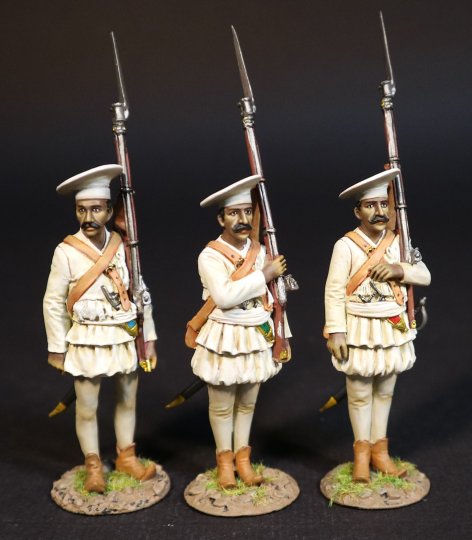
WFCIP-01
THE SEVEN YEARS WAR,
THE THIRD CARNATIC WAR 1756-1763,
THE BATTLE OF WANDEWASH, 22nd JANUARY 1760,
THE FRENCH ARMY,
FRENCH CIPAYE
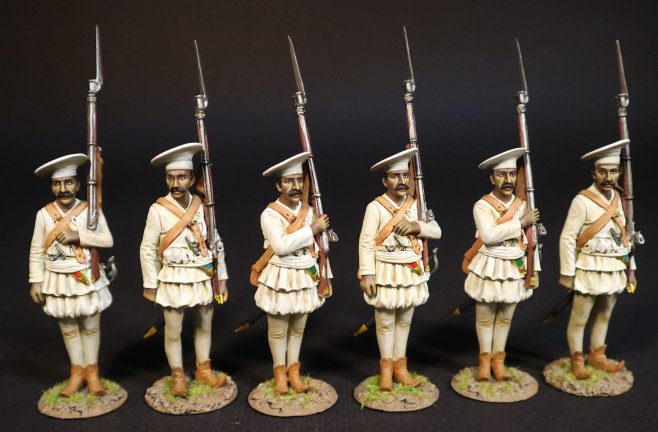
WFCIP-01N
THE SEVEN YEARS WAR,
THE THIRD CARNATIC WAR 1756-1763,
THE BATTLE OF WANDEWASH, 22nd JANUARY 1760,
THE FRENCH ARMY,
FRENCH CIPAYE
** PLEASE CONTACT YOUR LOCAL DEALER FOR FURTHER INFORMATION **
THE EIGHTEENTH CENTURY COLLECTION
THE AMERICAN WAR OF INDEPENDENCE
THE BATTLE OF BUNKER HILL, 17th JUNE 1775.
THE ASSAULT ON THE REDOUBT AT BREED’S HILL
Boston was the third largest town in North America, and stood on a Peninsula connected to the mainland by a neck just wide enough to cross at high tide. The harbour, large enough to be strategically significant, and central to the town’s economy, was formed by a chain of islands stretching out to sea, guarded by reefs and ledges.
North west of Boston was Charlestown, a largely rural peninsula one and a half miles long. Charlestown stood at the south east corner with three hills behind it. Bunker’s Hill, nearest the neck of the Peninsula, Breed’s Hill 200 yards above the town and Moulton’s Hill to the north east.

On the 16th June 1775, 3 detachments from Massachusetts regiments under the command of Colonel William Prescott and engineer Captain Richard Gridley, crossed the Charlestown neck and arrived at Bunker Hill.
Captain Richard Gridley and Prescott disagreed as to where they should locate their defense. Some work was performed on Bunker Hill, but Breed’s Hill was closer to Boston and viewed as being more defensible, and they decided to build their primary redoubt there.
Prescott and his men began digging a square fortification about 130 ft a side with ditches and earthen walls. The walls of the redoubt were about 6 feet high.
Work began at midnight, and around 4am one of the British warships spotted the earthworks on Breed’s Hill and opened fire.
The British command agreed that the works posed a significant threat, but were at this time sufficiently incomplete and isolated to offer a chance of a successful attack.
The original British plan was to bypass the redoubt to the north and capture Bunker’s Hill and the neck of the peninsula, thus isolating the redoubt on Breed’s Hill.
The Americans repulsed two British assaults, with significant British casualties. The British captured the redoubt on their third assault, after the defenders had run out of ammunition. The colonists retreated over Bunker Hill, leaving the British finally in control of the Peninsula.
The battle was a tactical victory for the British, but it proved to be a sobering experience for them; they incurred many more casualties than the Americans had sustained, including many officers. The battle had demonstrated that inexperienced militia were able to stand up to regular army troops in battle. Subsequently, the battle discouraged the British from any further frontal attacks against well defended front lines. American casualties were much fewer, although their losses included General Joseph Warren, and Major Andrew McClary, the final casualty of the battle.
BRITISH MARINES

The Marines, which only became “Royal Marines” in 1802, were the Royal Navy’s private army, administered by the Admiralty and controlled by senior naval officers. The rank and file were volunteers and wore army style uniforms and equipment. However they were trained to serve on warships and undertake amphibious operations. The 50 companies, shared between Chatham, Portsmouth and Plymouth, were not regimented, and detachments, or in some cases individual replacements were assigned on an ad hoc basis.
The first Marines sent to Boston were to form a battalion of 600 men under Major Pitcairn, but by March only 336 were present, as they soon became an object of inter service rivalry over pay, food and conditions. Although initially physically inferior to their army comrades, and short of essential equipment for service on land, incessant drilling and regular marches into the countryside soon created a fine unit.
Another group of over 700 men arrived in May, and the whole force formed two battalions, with grenadier and light companies.

MBHL-05
THE AMERICAN WAR OF INDEPENDENCE 1775-1783,
THE BATTLE OF BUNKER HILL, JUNE 17th 1775,
THE ASSAULT ON THE REDOUBT AT BREED’S HILL,
BRITISH MARINES,
2 MARINES MARCHING
The 1st and 2nd Marines were to play an important part in the assault on the southern defences of the Breed’s Hill redoubt.

MBHL-05N
THE AMERICAN WAR OF INDEPENDENCE 1775-1783,
THE BATTLE OF BUNKER HILL, JUNE 17th 1775,
THE ASSAULT ON THE REDOUBT AT BREED’S HILL,
BRITISH MARINES,
4 MARINES MARCHING
It was during one of the assaults by the 47th Regiment and the 1st Marines, that the American commander Prescott ordered his men to hold their fire until the British were within 30 yards. This action supposedly gave rise to the order, “Don’t fire till you see the whites of their eyes”!
The volley forced the Marines and regulars back out of range to regroup.
Adjutant, Lieutenant Waller, managed to reform two companies, and with the 47th Regiment on their left, the two battalions finally swarmed over the defences and into the redoubt, probably being the first troops to enter.

MBHL-06
THE AMERICAN WAR OF INDEPENDENCE 1775-1783,
THE BATTLE OF BUNKER HILL, JUNE 17th 1775,
THE ASSAULT ON THE REDOUBT AT BREED’S HILL,
BRITISH MARINES,
2 MARINE GRENADIERS MARCHING
This third attack was made at the point of the bayonet and successfully carried the redoubt. However the final volleys of fire from the colonists cost the life of Major Pitcairn. The defenders had run out of ammunition, redusing the battle to close combat. The advantage turned to the British as their troops were equipped with bayonets on their muskets, while most of the colonists were not.
Colonel Prescott, one of the last men to leave the redoubt, parried bayonet thrusts with his normally ceremonial saber.

MBHL-06N
THE AMERICAN WAR OF INDEPENDENCE 1775-1783,
THE BATTLE OF BUNKER HILL, JUNE 17th 1775,
THE ASSAULT ON THE REDOUBT AT BREED’S HILL,
BRITISH MARINES,
4 MARINE GRENADIERS MARCHING
THE BATTLE OF COWPENS, JANUARY 17th, 1781.
THE 7th REGIMENT OF FOOT (ROYAL FUSILIERS.)
The Battle of Cowpens was an engagement during the American Revolutionary War fought on January 17th 1781, near the town of Cowpens, South Carolina, between American forces under Brigadier General Daniel Morgan, and British forces under Lieutenant Colonel Banastre Tarleton, as part of the campaign in the Carolinas.
The battle was a turning point in the American reconquest of South Carolina from the British.
Tarleton’s force of 1,000 British troops were set against 2,000 troops under Morgan. Morgan’s forces suffered casualties of only 25 killed and 124 wounded. Tarleton’s force was almost completely eliminated with almost 30% casualties and 55% of his force captured or missing, with Tarleton himself and only about 200 British troops escaping.
Morgan’s forces conducted a double envelopment of the British forces, the only double envelopment of the war.

The Royal Fusiliers (city of London Regiment) was a line infantry regiment of the British Army which has been in continuous existence for 283 years. It was known as the 7th Regiment of Foot until the Childers Reforms in 1881.
In 1747 the regiment was known as the Royal English Fuziliers and was given the precedence of 7th in the Infantry of the Line. On 1st July 1751 it was redesignated as the 7th Regiment of Foot (Royal Fusiliers).
When county titles were added in August 1782 the subtitle (Derbyshire) was added, but this was never used and was later given to a different regiment.
The Royal Fusiliers were sent to Canada in April 1773. The regiment was broken up into detachments that served at Montreal, Quebec, Fort Chambly and Fort St. Johns. In the face of the American invasion of Canada in 1775/76, the 80 man garrison of Fort Chambly attempted to resist a 400 man Rebel force but ultimately had to surrender, losing its regimental colours as a result. The bulk of the regiment was captured when St. John’s fell.
A 70 man detachment under the command of Captain Humphrey Owens assisted with the Battle of Quebec in December 1775.
The men taken prisoner during the defence of Canada were exchanged in British held New York city in December 1776. Here the regiment was rebuilt and garrisoned New York and New Jersey. In October 1777, the 7th participated in the successful assaults on Fort Clinton and Fort Montgomery and the destruction of enemy stores at Continental Village. In late November, 1777 the regiment reinforced the garrison of Philadelphia. During the British evacuation back to New York city, the regiment participated in a diversionary raid in the days leading up to the Battle of Monmouth in June 1778.
In April 1780, the Royal Fusiliers took part in the capture of Charleston. Once Charleston fell, the regiment helped garrison the city. Three companies were sent to Ninety-Six to assist with the training of Loyalist militia companies. An 80 man detachment was also sent to Camden, South Carolina to help build that town’s defences. The detachments were recalled to Charleston for refitting in late August 1780.
The 7th, mounted on horses, along with the two regiments of Loyalist militia, cleared the region north of Georgetown, South Carolina of partisans while en route. The Royal Fusiliers turned the horses over to Lieutenant Colonel Banastre Tarleton’s British Legion upon uniting with Cornwallis in late September and then served as the Army’s rearguard.

CW7FL-03
THE AMERICAN WAR OF INDEPENDENCE 1775-1783,
THE BATTLE OF COWPENS, JANUARY 17th 1781,
7th REGIMENT OF FOOT (ROYAL FUSILIERS.)
STANDARD BEARER
Between October 1780 and early 1781, the regiment, having lost about one third of its officers and men to sickness and disease, protected the communication and supply lines between Camden and Winnsboro, South Carolina. On 7th January, 1781, a contingent of 171 men from the Royal Fusiliers was detached from Cornwallis’s Army and fought under the command of Tarleton at the Battle of Cowpens in January 1781.
The Royal Fusiliers were on the left of the line of battle: Tarleton was defeated and the regiment’s colours were once again captured, and stored in the baggage wagons.
A 19 man detachment from the regiment fought through North Carolina participating in the Battle of Guilford Court House in March 1781 and ultimately the siege of Yorktown, where it served with the regiment’s Light Infantry Company. There was another detachment, composed largely of men recovered from the hospitals and recruits, which remained in the South under the command of Lt. Col. Alured Clarke. These men remained in garrison in Charleston, until they were transferred to Savannah, Georgia in December 1781.
The regiment returned to England in 1783.
THE SEVEN YEARS WAR
THE THIRD CARNATIC WAR 1756-1763
THE BATTLE OF WANDEWASH, 22nd JANUARY 1760
THE BRITISH ARMY
The Battle of Wandewash was a confrontation between the French under the command of The Comte de Lally, and the British Sir Eyre Coote. It was the decisive battle in the Anglo French struggle in southern India during the Seven Years War.
Lally, cut off from sea support by the withdrawal of Admiral d’Aché’s fleet and hampered by a lack of funds and by dissensions among his troops, tried to recover the fort of Wandiwash near Pondicherry.
There he was attacked and routed by Coote, with about 1,700 British troops against about 2,000 French. Lally’s best general, the marquis de Bussy, was captured. The French were thereafter confined to Pondicherry, which surrendered on Jan. 16, 1761, after much privation. Lally was later imprisoned and executed, after a trial in Paris, for alleged treason
The following two British regular units served in India and were present at the battle of Wandewash. It should be noted however that it was rare for these units to serve as complete battalions, and that they were generally broken up into detachments.
The British 79th Regiment of Foot, was raised in November 1757, originally as the 64th with drafts taken from the 4th, 8th and 24th foot, but was later re-numbered during the shake up after various second Battalions were taken into the line.
The regiment was to mainly see service in India from 1758, and was disbanded in 1764. Its commander was Major Brereton.
The 84th (Coote’s) Regiment was raised in January 1759, specifically for service in India.
The regiment was ordered home to be disbanded in 1764, but was instead reduced in India and most of the personnel were to enter the East India Company service.
Initially the Madras European Regiment were not conventionally organized infantry battalions. Their organization, or what there was of it, resembled that of the marines, serving in effect as a pool from which more or less ad hoc companies and detachments could be formed for specific tasks.As long as the East India Company’s need was for purely defensive forces, tasked with watching over its factories and escorting merchants and officials this informal organization was adequate.
BRITISH SEPOYS


WBS-01
THE SEVEN YEARS WAR,
THE THIRD CARNATIC WAR 1756-1763,
THE BATTLE OF WANDEWASH, 22nd JANUARY 1760,
THE BRITISH ARMY,
BRITISH SEPOY OFFICER
At the outset native units were in effect mercenary bands, recruited, equipped and led by their own officers, and generally referred to as Peons. By 1750 the East India Company were training and equipping their native soldiers in European fashion, and distinguishing them from the earlier rabble by using the term Sepoys instead.
In Bengal the first permanent unit of Sepoys was formed by Clive in early 1757. Clive dressed the Bengal Sepoys in red which was also adopted by the Madras units in 1759.
FRENCH CIPAYE
The early French Cipayes, were similar to their British counterparts as they initially wore their own costume rather than a European style uniform.
These figures are based on the well known Rousselot renderings, and are wearing a muslin headdress with a wide flat top which it is believed was intended to protect the wearer against sword cuts. The conventional long gown which was fastened by ties on the left hand side, and was worn tucked up around the hips.
About 900 French Cipayes were positioned on a ridge slightly to the rear of the main French line. They were to take no part in the actual Battle of Wandewash. A further 300 Cipayes were left to guard the French camp

WFCIP-01
THE SEVEN YEARS WAR,
THE THIRD CARNATIC WAR 1756-1763,
THE BATTLE OF WANDEWASH, 22nd JANUARY 1760,
THE FRENCH ARMY,
FRENCH CIPAYE

WFCIP-01N
THE SEVEN YEARS WAR,
THE THIRD CARNATIC WAR 1756-1763,
THE BATTLE OF WANDEWASH, 22nd JANUARY 1760,
THE FRENCH ARMY,
FRENCH CIPAYE
** PLEASE CONTACT YOUR LOCAL DEALER FOR FURTHER INFORMATION **

